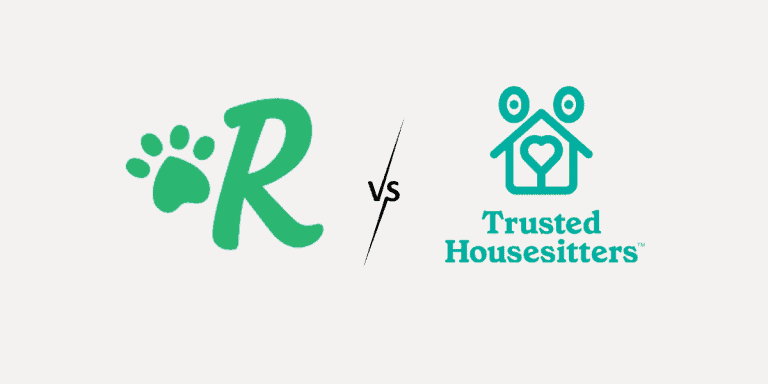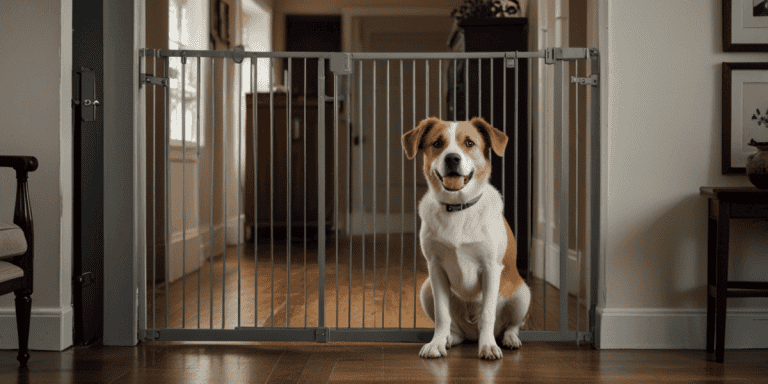Build Trust as a Pet Sitter: 5 Proven Strategies

Trust is important. Losing your customer’s trust can hurt your reputation (I’m looking at you, Boeing), or even put you out of business (probably for the best, Ashley Madison).
Recent research by Adobe found that brands that earn customer trust are rewarded with more sales, loyalty, and positive recommendations. No surprises there.
So how can you build trust with your clients in your own pet sitting business?
In this post, I’ll be looking at 5 tried-and-tested ways you can build trust with your clients as a pet sitter. Some of them are simple and you might say, obvious, but this is a good thing.
Building trust with your clients is about doing the basics well and adding extra value to your customers where they’ll actually appreciate it.
Let’s look at the strategies:
Want to know more about the ins and outs of pet sitting in general? Check out this ultimate guide!
1. Certifications and Insurance
How do you convince pet owners that you’re the right person for the job? A good start is to have certifications and insurance in place to show that you take your responsibilities seriously. Let’s discuss why these credentials are so important and how they can help you build trust with potential clients.
The Importance of Professional Qualifications
When pet owners are searching for someone to care for their beloved companions, they’re looking for more than just an animal lover. They want a professional who understands the ins and outs of pet care. That’s where professional qualifications come in. Certifications show that you’ve taken the time to learn about animal behaviour, first aid, and proper care techniques.

Certifications for UK Pet Sitters
In the UK, there are several certifications that can boost your credibility as a pet sitter. Here are a few to consider:
- Pet First Aid Certificate: This certification teaches you how to handle pet emergencies, which is crucial for any pet sitter. Organisations like Pet First Aid UK offer comprehensive courses.
- NARPRC Level 3 Diploma in Animal Care: This qualification covers a wide range of topics, including animal health, welfare, and behaviour.
- City & Guilds Level 2 Certificate in Animal Care: This course provides a solid foundation in animal care and welfare.
The Benefits of Pet Sitting Insurance
Insurance might not be the first thing that comes to mind when you think about pet sitting, but I’d highly recommend you get some.
Pet sitting insurance protects both you and your clients in case of accidents or unexpected events.
For example, if a pet in your care accidentally damages a client’s property, or if you’re injured while on the job, insurance can cover the costs. This gives both you and your clients peace of mind, knowing that you’re prepared for any situation.
Several UK insurance providers offer policies specifically tailored for pet sitters. Look for policies that cover public liability, care, custody and control, and key replacement.
How Credentials Build Credibility
When you have the right certifications and insurance, you’re not just saying you’re a professional – you’re proving it.
Credentials show potential clients that:
- You take your job seriously
- You’re committed to ongoing education and improvement
- You’re prepared for emergencies
- You’re running a legitimate, responsible business
Pro tip: Display your certifications prominently on your website and social media profiles. You can even create a dedicated “Qualifications” page that explains what each certification means and how it benefits your clients.

2. Create a Professional Online Presence
Nowadays, your customers will expect you to have some sort of online presence. It’s often the first impression potential clients will have of your pet sitting business when they first discover you. A well-crafted online presence can make the difference between a client choosing you or that know-it-all, Keith, down the road.
The Power of a Well-Designed Website
Your website is the virtual home of your pet sitting business. It’s where potential clients go to learn about your services, pricing, and what makes you unique.
Here’s what to focus on:
- Clear navigation: Make it easy for visitors to find information about your services, rates, and how to book.
- Professional design: Use high-quality images of happy pets and their owners. Ensure your website looks good on both desktop and mobile devices.
- About page: Share your story, experience, and why you’re passionate about pet sitting. This helps create a personal connection with potential clients.
- Services and rates: Be transparent about what you offer and how much you charge. This builds trust and saves time for both you and potential clients.
Pro tip: Include a FAQ section on your website. This not only provides valuable information to potential clients but also shows that you’re knowledgeable and prepared. It’s also something that Google will expect to see when it’s deciding how high it should rank your business on its search engine.
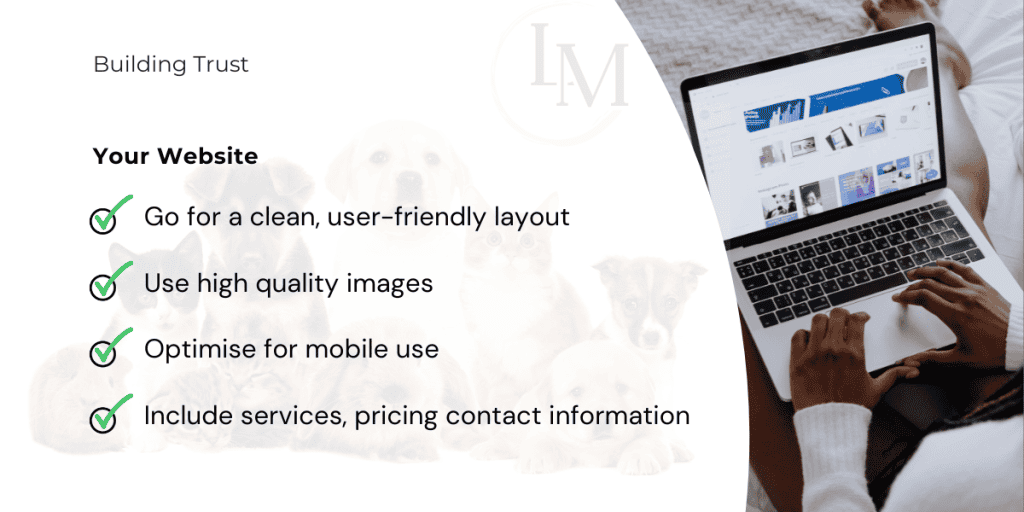
Leveraging Social Media to Build Trust
Social media platforms help you connect with pet owners and showcase your pet sitting skills.
Here’s how to make the most of them:
- Choose the right platforms: Focus on visual platforms like Instagram and Facebook where you can share cute pet photos and videos.
- Post consistently: Aim to post at least 3-4 times a week. Use a content calendar to plan your posts in advance.
- Share behind-the-scenes content: Give followers a glimpse into your daily life as a pet sitter. This could include photos of your pet care kit, videos of you playing with pets, or tips for pet care.
- Engage with your audience: Respond to comments and messages. This shows that you’re attentive and care about communication – key traits for a pet sitter.
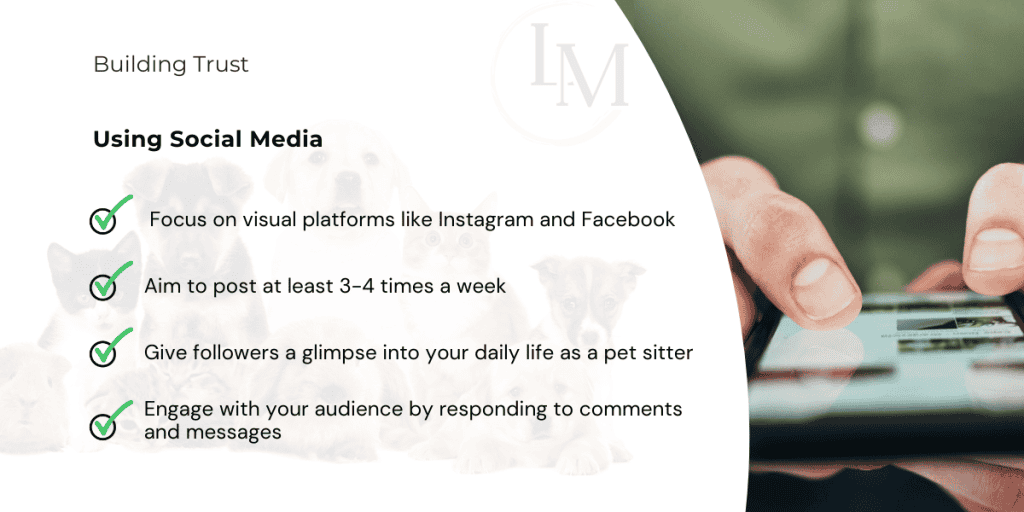
The Value of Client Testimonials
Nothing builds trust quite like hearing from happy clients. Testimonials provide social proof that you’re reliable and great at what you do.
Here’s how to use them effectively:
- Ask satisfied clients for reviews: Don’t be shy about asking for testimonials after a successful pet sitting job.
- Use a variety of formats: Written reviews, video testimonials, and before-and-after photos can all be powerful.
- Highlight specific benefits: Encourage clients to mention specific aspects of your service they appreciated, like your reliability or how calm their pet was when they returned.
- Display testimonials prominently: Feature them on your homepage, services page, and sprinkle them throughout your website.
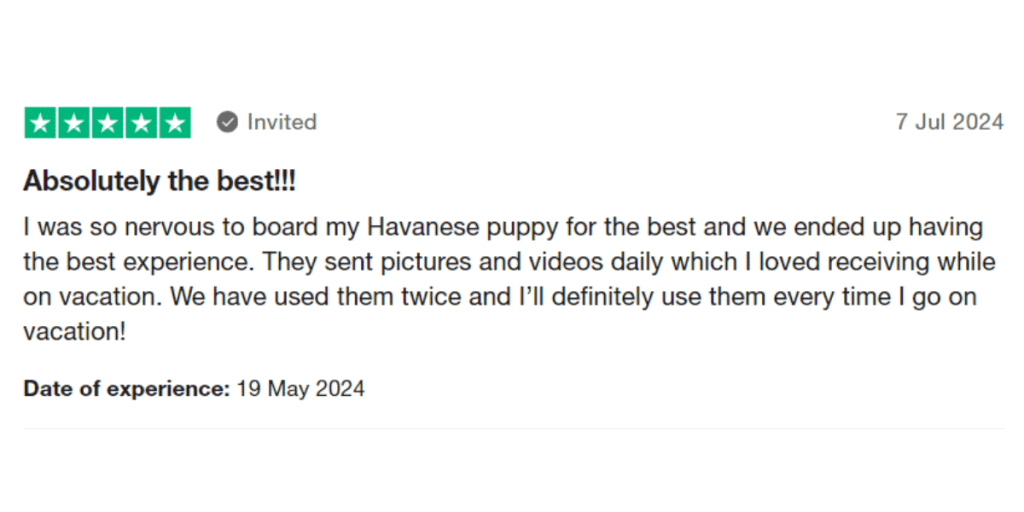
Presenting Your Services and Experience Effectively
When it comes to showcasing your pet sitting services and experience online, it’s all about painting a clear picture for potential clients.
Here are some tips:
- Create detailed service descriptions: Instead of just listing “Dog Walking”, describe what a typical walk entails. For example, “30-minute energetic walks in local parks, with fresh water and treats provided”.
- Highlight your experience: If you’ve been pet sitting for 5 years, or have cared for 100 different pets, say so! Quantifiable experience builds confidence.
- Show your range: If you’re comfortable with different types of pets or have experience with special needs animals, make sure to mention this.
- Use visual aids: Create infographics or short videos explaining your pet sitting process. This can help potential clients understand exactly what to expect when they book your services.
3. Offer a Meet-and-Greet Service
A pre-sitting consultation, often called a meet-and-greet, is a fantastic way to build trust with potential clients. This initial meeting allows you to get to know the pet and its owners, assess the pet’s needs, and show your professionalism in person.
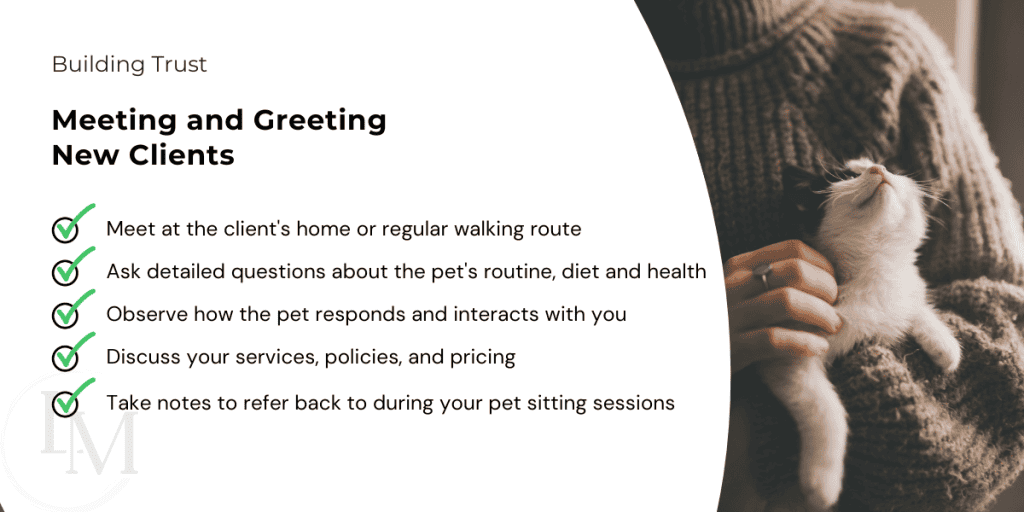
What is a Pre-Sitting Consultation?
A pre-sitting consultation is a brief meeting between you, the pet owner, and their pet before any pet-sitting services begin. This meeting typically takes place at the pet owner’s home or on a walking route that the pet is familiar with and serves several purposes:
- It allows the pet to meet you in a comfortable environment
- You can discuss the pet’s routines, needs, and any special care instructions
- The owner can ask questions and get to know you better
- You can familiarise yourself with the home layout and where pet supplies are kept (useful if you’re offering dog walking services or pet sitting in the owner’s home)
How to Conduct an Effective Meet-and-Greet
To make a great impression during your meet-and-greet, follow these steps:
- Be punctual: Arrive on time or a few minutes early. This shows respect for the owner’s time and demonstrates your reliability.
- Dress appropriately: Wear clean, comfortable clothes suitable for interacting with pets.
- Bring necessary items: Have a notepad to jot down information, business cards, and any forms the owner needs to fill out.
- Ask thoughtful questions: Inquire about the pet’s routine, favourite toys, and any health issues. This shows you’re thorough and care about providing personalised service.
- Interact with the pet: If the pet seems comfortable, ask the owner if you can offer a treat or toy. This helps you start building a bond with the pet.
Assessing the Pet’s Needs and Routines
During the meet-and-greet, gathering detailed information about the pet’s needs and routines will help you give the best care to the pet and will help build trust with the owner.
Here are some key points to cover:
- Feeding schedule: Note the type of food, portion sizes, and feeding times.
- Exercise requirements: Ask about usual walking routes, play routines, and exercise preferences.
- Medications: If the pet needs medication, get clear instructions on dosage and administration.
- Behavioural quirks: Learn about any specific behaviours to watch for, like fear of thunderstorms or tendency to chew certain items.
- Emergency contacts: Get the vet’s contact information and an emergency contact person.
Making a Great First Impression
Your goal during the meet-and-greet is to show both the pet and the owner that you’re trustworthy, competent, and caring.
Here are some tips:
- Show genuine interest: Ask about the pet’s history and listen attentively to the owner’s stories.
- Demonstrate your knowledge: Share relevant pet care tips or observations about the pet’s breed.
- Be honest: If there’s a service you can’t provide or a situation you’re not comfortable with, say so. Honesty builds trust.
- Follow up: After the meeting, send a thank-you email summarising the key points discussed. This reinforces your professionalism and attention to detail.
For a little more information on nailing your meet and greet, check out this dedicated post.
4. Maintain Clear Communication
Good communication is the backbone of any successful pet sitting business.Getting information to your clients is one thing, but it’s also about building a relationship with your clients
The Value of Fast and Professional Communication
Quick responses and clear messages show clients that you’re attentive and responsible. Here’s why it matters:
- Reduces anxiety: Pet owners often worry about their furry friends. Prompt replies ease their concerns.
- Shows professionalism: Timely communication demonstrates that you take your job seriously.
- Builds trust: When clients know they can reach you easily, they’re more likely to trust you with their pets.
Pro tip: Set up auto-replies for times when you can’t respond immediately. A message like “I’m currently caring for pets and will respond within 2 hours” reassures clients without interrupting your work.
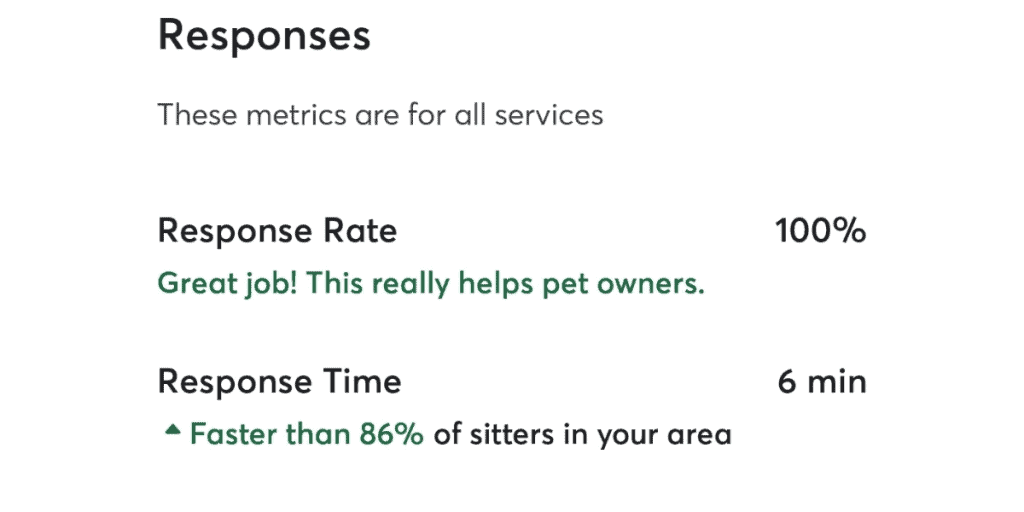
Communication Methods
Different clients prefer different communication styles. Offering different options can help you cater to everyone’s needs:
- Text messages: Great for quick updates and time-sensitive information.
- Email: Useful for longer messages, detailed instructions, or sending documents.
- Phone calls: Ideal for complex discussions or emergencies.
- Pet sitting apps: Many apps offer in-built messaging, photo sharing, and scheduling features.
Key point: Ask each client about their preferred method of communication during your initial meeting.
Setting Clear Expectations with Clients
Clear expectations prevent misunderstandings and build trust.
Here’s how to set them:
- Create a service agreement: Outline your services, rates, cancellation policy, and emergency procedures in a written document.
- Discuss boundaries: Be clear about your working hours and response times for non-emergency situations.
- Explain your process: Tell clients how often you’ll update them and what kind of information you’ll provide.
Providing Regular Updates During Pet Sitting Assignments
Regular updates reassure pet owners and keep them connected to their pets, helping to build trust.
Follow these tips:
- Set a schedule: Decide with the client how often they want updates. Some prefer daily, others are happy with every other day.
- Use photos and videos: A picture of a happy pet can brighten an owner’s day and show that you’re doing a great job.
- Be specific: Instead of “The dog is fine,” try “Max enjoyed a 30-minute walk in the park and ate all his dinner.”
- Report any issues promptly: If something seems off with the pet, let the owner know right away. They’ll appreciate your attentiveness.
Handling Difficult Conversations
Sometimes, you’ll need to communicate about challenging situations.
Here’s how to handle them:
- Stay calm and professional: Even if a client is upset, maintain your composure.
- Focus on solutions: If there’s a problem, present a plan to resolve it.
- Be honest: If you make a mistake, own up to it. Honesty builds trust, even in tough situations.
- Follow up: After resolving an issue, check in with the client to ensure they’re satisfied.
5. Build Trust by Going Above and Beyond
Doing a little extra and exceeding your customers expectations can often give you back a lot more than you put in. Let’s start with the basics then look at some ideas for going the extra mile.
The Importance of Reliability and Punctuality
In any gig economy or service industry job, you won’t last long unless you can be depended on to show up when you say you will and do what you say you’ll do. It’s especially important when caring for pets.
Here’s why it matters:
- Peace of mind: Owners relax knowing their pets are in capable, dependable hands.
- Respect for schedules: Pets thrive on routine, and sticking to it shows your commitment to their wellbeing.
- Professional image: Consistent punctuality marks you as a serious, trustworthy professional.
Pro tip: Always plan to arrive 5-10 minutes early for appointments. This buffer allows for unexpected delays and shows your respect for the client’s time.
Providing Personalised Care for Each Pet
Every pet is unique, with its own personality, needs, and quirks. Tailoring your care demonstrates your attention to detail and genuine interest in the pet’s wellbeing.
Here’s how to personalise your care:
- Keep detailed notes: Record each pet’s preferences, routines, and any special requirements.
- Adapt your approach: Some pets love playtime, others prefer quiet companionship. Adjust your style to suit each animal.
- Remember the little things: Did Fluffy love that special chin scratch? Does Rex have a favourite toy? Remembering these details will make you a hit with both pets and owners.
Additional Services That Set You Apart
Offering extra services can make you the go-to pet sitter in your area. Not all of these might suit your business, and some of them might require a little more training, but adding even one valuable extra service can help set you apart.
Here are some ideas:
- House sitting: Some owners prefer their pets to stay in familiar surroundings.
- Plant watering: A simple task that you can do when collecting pets or when a client is on holiday..
- Mail collection: Helps maintain home security while owners are away.
- Pet grooming: If you’re skilled, offering basic grooming can be a great add-on.
- Pet taxi services: Transportation to vet appointments or grooming sessions.
Key point: Always check your insurance covers any additional services you offer.
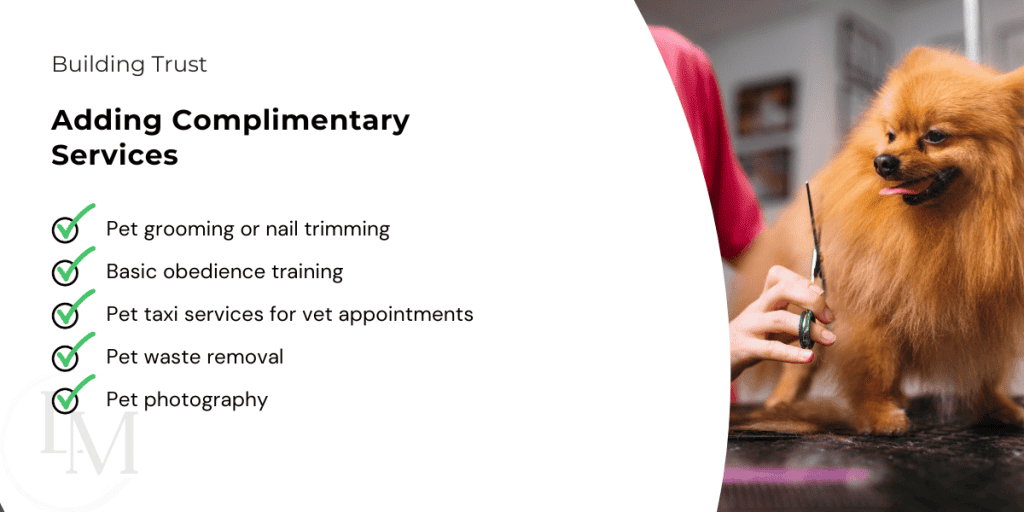
Keeping the Home Clean and Tidy
If you’re house-sitting, returning to a clean home after a trip is a relief for pet owners.
Follow these tips:
- Clean up any pet messes promptly: This prevents stains and odors.
- Tidy pet areas: Wash food bowls, clean litter boxes, and organize toys.
- Spot clean as needed: Wipe down surfaces the pet frequents.
- Take out the trash: Especially important for longer sitting assignments.
Going the Extra Mile
Small gestures can make a big impact – this is where you can shine as a pet sitter and customer service provider.
Try these ideas:
- Leave a ‘report card’: Summarise your visits, noting the pet’s mood, activities, and any observations. Some Apps like Rover have these systems built in – use them.
- Take photos or videos: Capture fun moments to share with the owner.
- Bring a small gift: A new toy or treat (with the owner’s permission) shows you care.
- Learn basic pet first aid: This knowledge provides peace of mind for you and the owner.
Handling Emergencies with Grace
Being prepared for emergencies is crucial. Here’s how to handle them:
- Keep emergency contacts handy: Have quick access to the vet’s number and owner’s preferred contact method.
- Stay calm: Your composure will help keep the pet calm too.
- Communicate clearly: Inform the owner promptly about any issues, detailing the problem and your actions.
- Follow up: After resolving an emergency, check in with the owner to ensure they’re satisfied with how it was handled.
Conclusion: 5 Proven Ways to Build Trust as a Pet Sitter
Pretty straightforward right?
Building trust with your clients as a pet sitter comes down to two simple things. Getting the basics that apply to any business right, and adding value to your customers as a pet sitter.
A modern, trustworthy business should have an online presence, be able to communicate clearly and honestly with their customers about their pricing, services and policies, and should be there for you when things don’t go as planned.
As a pet sitter, you can build on these foundations by building trust in ways that your clients will appreciate. You can do this by gaining pet first aid certificates, offering meet and greet services and going the extra mile for the pets in your care.
If you’re still not convinced that building trust is one of the cornerstone foundations on which you should build your business, I hear Boeing are hiring.





